

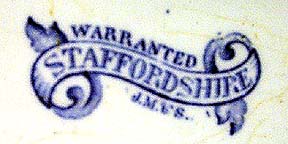 BLUE & WHITE CROCKERY
BLUE & WHITE CROCKERY
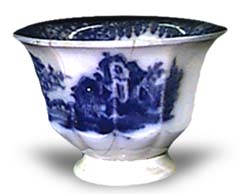 |
Blue and white porcelain cup with European and Arabic design. CAS 0389-0267 |

CHRONOLOGY
The Dictionary of Blue and White Printed Pottery lists the following chronology for the production of English Blue and White pottery:
Chinosserie Period (1780-1800): Designs copied from expensive Chinese wares were originally applied to ceramic wares that were already glazed, hence the term, on-glaze printing. Excess ink on the copper plates often produced dark and sometimes blurred images, and because the designs were easily damaged or rubbed off, the wares were used only for decorative purposes. Production was generally for the wealthy classes.
First Transitional Period (1800-1815): Eventually, the design transfer process was applied to inexpensive wares which were glazed after the design was applied. Under-glaze wares were cheaper to produce and durable enough for daily use. Stipple engraving allowed more light and shading in designs, increasing a blend of Chinese and European motifs. By incorporating and blending references from many cultures, Victorian designs increasingly became more and more exotic.
|
|
Rim detail of cup shown above. Arabic lobed arch with grape leaves. CAS 0389-0267 |
![]()
Vintage Period (1815-1835): An expanding British Empire and the end of the Napoleonic wars opened new markets in North America, Europe, and the British colonies. Potters copied designs by the finest artists from illustrated books. Complete dinner services with names like "British Views" or "Picturesque Scenery" were produced.
| Eton College pattern: clay rectangular meat platter. Picturesque scenery with a man, woman, child, and view of the college. CAS 0389-1365 | 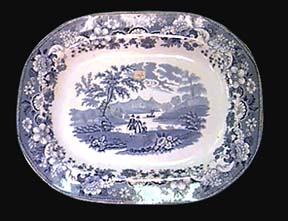 |
![]()
Second Transitional Period (1835-1845): The development of clearer and smoother glazes permitted the use of colors such as sepia, green, and mulberry in the designs. The middle class market was nearing the saturation point.
Romantic Period (1845-1860): The British Copyright Act of 1842 prevented potters from copying designs from books or from using another's hallmark. Thereafter, they developed new and original designs, emphasizing romantic patterns and individual hallmarks.
 |
Hallmark from platter shown below (center). Willow Pattern. Hallmark "J.M.&S.": Job Meigh & Son (1812-1834), John Meir & Son (1841-1897), or John Maddock & Son (1855-1869). CAS 0389-1363 |
![]()
Final Decline (1860-1880): After a century of blue-printed pottery production, quality had fallen to mostly bad copies. The popular "Willow Pattern" however, continued in production.
WILLOW PATTERN

Originally derived from the Chinese, it is impossible to ascribe the early versions of the Willow pattern to any particular English potter because hallmarks were not used and the patterns are virtually identical. First developed in the early 19th Century and popularized in the Victorian era, the standard pattern shows a willow tree shading a bridge. Three figures cross the bridge, with a pagoda and garden wall to the right, a boat and another pagoda to the left, and a pair of doves overhead. The scene is explained in the following legend:
" Li-Chi, a Chinese Mandarin, lived in a pagoda with his beautiful daughter, Koong-Shee, who was to marry an elderly merchant, Ta-Jim. Koong-Shee, however, fell in love with her father's secretary, Chang, and when the father discovered that the two were meeting secretly, he dismissed Chang. Undaunted, the young lovers elope, and with the gardener's assistance, they cross the bridge spanning the river. After going to Chang's house by boat, the mandarin discovers them and pursues them. They are nearly overtaken and beaten to death when the gods intervene and turn them into a pair of doves."
|
A) Hallmark: "Semi China" inside of square, and Ridgeway Hallmark (arch with arrows). CAS 0389-1362
B) Hallmark: "WARRANTED STAFFORDSHIRE; J.M.&S." signifies one of the following: Job Meigh & Son (1812-1834); John Meir & Son (1841-1897); John Maddock & Son (1855-1869). CAS 0389-1363
C) No hallmarks. CAS 0389-1369 |
 BLUE
& WHITE BIBLIOGRAPHY
BLUE
& WHITE BIBLIOGRAPHY
| COYSH, A.W. & R.K. HENRYWOOD The Dictionary of Blue and White Printed Pottery, 1780-1880. London, Antique Collectors' Club. 1982 |
| GODDEN, GEOFFREY An Illustrated Encyclopedia of British Pottery & Porcelain. New York, Crown. 1966 |
| LITTLE, WILFRED LAURENCE Staffordshire Blue: Underglaze Blue Transfer-Printed Earthenware. New York, Crown. 1969 |
 |
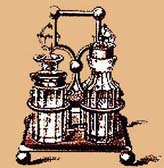 |
 |
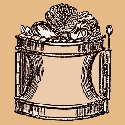 |
|
| Kitchen Technology | Silversmithing | Blue & White Crockery | Food Molds | Victorian Kitchens Home |